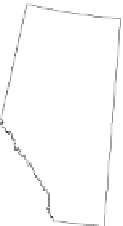Biology Reference
In-Depth Information
include tumbling plant architecture, a facultative outcrossing breeding system, evo-
lution of resistant biotypes to ALS inhibitor herbicides (Morrison and Devine 1994;
Heap 2008), drought tolerance (Erickson and Moxon 1947), tolerance to saline and
alkaline/high pH soils (Erickson and Moxon 1947), and tolerance to predation by
grasshoppers (
Melanoplus
and
Camnula
spp.) and other insects (Olfert et al. 1990).
Kochia is one of the top ten most abundant agricultural weeds in the Prairies; it
is undergoing rapid range expansion in western Canada (Leeson et al. 2005b).
Since the 1970s and 1980s, kochia has expanded northward into cooler, wetter
regions from traditional areas in the southern semiarid grassland region of the
Prairies (Fig. 8.3), and has recently been reported in the most northern agricultural
areas (Maurice, personal communication). It is also increasing in abundance, as
exemplified by its increased relative abundance ranking (increase of 14 positions)
from the 1970s to 2000s (Leeson et al. 2005b). In contrast to kochia, the distribu-
tion and abundance of Russian thistle (
Salsola tragus
L.) has remained static or
declined over the past 40 years (Leeson et al. 2005b) even though it apparently is
biologically and ecologically similar to kochia (Crompton and Bassett 1985).
Limitations to the northern expansion of kochia have been attributed in the past
to its inability to flower under long-day conditions because it is a short-day plant,
1970s
1980s
1990s
2000s
Frequency
Species not surveyed
0.1 to 10.0%
20.1 to 50.0%
Absent
10.1 to 20.0%
More than 50.0%
Fig. 8.3
Percent frequency of kochia in surveyed Canadian Prairie province fields (Alberta,
Saskatchewan, Manitoba - left to right) from the 1970s to the 2000s. ALS inhibitor resistance in
kochia was initially documented in the 1990 surveys. In 2007, a random survey of over 100 fields
across all agricultural ecoregions in the three provinces found that over 80% of sites had ALS inhibi-
tor-resistant populations (Beckie, unpublished data). Adapted from Leeson et al. (2005b), p. 349

































































































































































































































































































































































































































































































































































































































